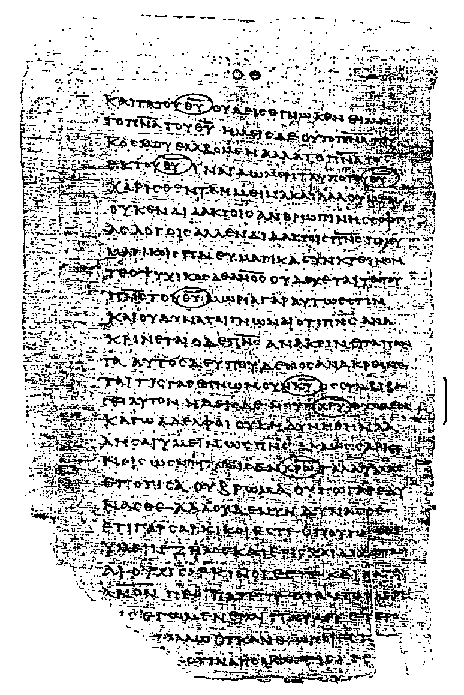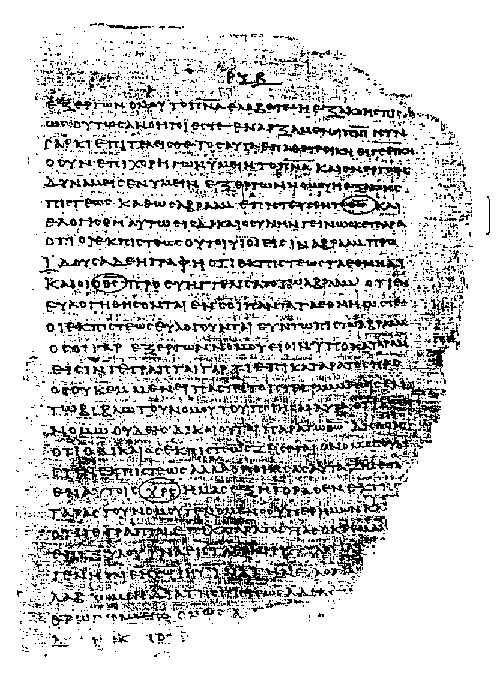
| Home | Chapter Index | Appendix Index | Complete on-line NWT |
Many early Greek manuscripts are available for examination in facsimile form. (Facsimile copies are photographically reproduced plates of the actual manuscripts themselves. Generally, the manuscripts are in page format.) One of the earliest Greek Scripture manuscripts available today is known as the Chester Beatty Papyri and is cataloged as P46. This manuscript has been dated as a copy made about 200 C.E. Therefore, these copies were made not more than 150 years after the Apostle Paul wrote between 50 and 61 C.E.
The material in this appendix comes from the book entitled, The Chester Beatty Biblical Papyri, Descriptions and Texts of Twelve Manuscripts on Papyrus of the Greek Bible. The editor is Frederic G. Kenyon; the book was published by Emery Walker Ltd. of London in 1937.
Our best description comes from the Preface of the volume itself:
This [volume] contains a complete photographic reproduction of the papyrus of the Pauline Epistles, the ownership of which is divided between Mr. Chester Beatty and the University of Michigan…Since the complete codex [book] appears to have consisted of 104 leaves (of which the last five may have been blank), the student now has a reproduction of a nearly complete copy of the Epistles of St. Paul (apart from the Pastorals [1 2 Timothy and Titus]), at least a century older than any MS. [manuscript] previously known. It seems certain that the papyrus is not later than the first half of the third century; and Prof. Ulrich Wilcken, the first living authority on papyrology, would date it 'round about A.D. 200.' It thus has a strong claim to be considered the earliest extant MS. of the New Testament [Christian Greek Scriptures] of any substantial size, and to have been written not more than a century and a half after the death of St. Paul.
The Watch Tower Society recognizes P46 from "circa 200 C.E." Thus, from the following reproductions of this copy of the Greek Scriptures, we can see that the use of the Greek word Kyrios (rather than יהוה) can be established not later than this very early date.
[1] "All Scripture Is Inspired of God and Beneficial," Watch Tower Bible and Tract Society, p. 313.
The following summary of P46 lists 28 instances in which the New World Translation uses Jehovah as its translation of Kyrios (or Theos). Plate No. : the papyrus leaf identification number (marked as "r" for recto [front] and "v" for verso [back]). Plate Contents: the verses found on the papyrus leaf. Verse Cited: Jehovah reference from the New World Translation. Entry: the surrogate (abbreviation) found in P46. KIT : the word entry in the Kingdom Interlinear Translation.
| Plate No. | Plate Contents | Verse Cited | Entry | KIT |
| f.16.r. | Rom 12:11-13:1 | Rom 12:11 | Κς[*] | κυρίω |
| f.19.v. | Rom 15:11-19 | Rom 15:11 | Κν | κύριον |
| f.23.v. | Heb 2:2-3:3 | Heb 2:13 | θς[2] | θεός |
| f.28.r. | Heb 7:28-8:8 | Heb 8:2 | Κς | κύριος |
| f.31.r. | Heb 10:8-20 | Heb 10:16 | Κς | Κύριος |
| f.37.v. | Heb 13:3-11 | Heb 13:6 | Κς | Κύριος |
| f.40.r. | 1 Cor 2:11-3:5 | 1 Cor 2:16 | ΚΥ | Κυρίον |
| f.41.r. | 1 Cor 3:16-4:3 | 1 Cor 3:20 | Κς | Κύριος |
| f.42.v. | 1 Cor 4:4-10 | 1 Cor 4:4 | Κς | κύριος |
| f.45.r. | I Cor 7:12-19 | 1 Cor 7:17 | Κς | κύριος |
| f.50.r. | I Cor 10:21-30 | 1 Cor 10:21 | Κς | Κυρίου |
| Same citation as above | 1 Cor 10:21 | Κς | Κυρίου | |
| 1 Cor 10:22 | Κν | κύριον | ||
| f.56.r. | I Cor 14:16-23 | I Cor 14:21 | Κς | Κύριος |
| f.60.r. | I Cor 16:2-12 | I Cor 16:7 | Κς | κύριος |
| Same citation as above | I Cor 16:10 | ΚΥ | Κυρίον | |
| f.64.r. | 2 Cor 3:14-4:3 | I Cor 3:16 | Κν | Κύριον |
| Same citation as above | I Cor 3:17 | ? | κύριος | |
| I Cor 3:17 | ΚΥ | Κυρίου | ||
| I Cor 3:18 | ΚΥ | Κυρίου | ||
| I Cor 3:18 | ΚΥ | κυρίου | ||
| f.67.r. | 2 Cor 6:14-7:4 | 2 Cor 6:17 | Κς | Κύριος |
| Same citation as above | 2 Cor 6:18 | Κς | Κύριος | |
| f.71.r. | 2 Cor 10:11-11:2 | 2 Cor 10:17 | Κς | Κυρίω |
| Same citation as above | 2 Cor 10:18 | Κς | κύριος | |
| f.77.r. | Eph 2:21-3:10 | Eph 2:21 | Κς | κυρίω |
| f.80.v. | Eph 6:8-18 | Eph 6:8 | ΚΥ | κυρίου |
| f.83.r. | Gal 3:2-15 | Gal 3:6 | θς | θεω |
[*] All surrogates in this table have an overline above the Greek letters.
[2] The final sigma (ς) in manuscript entries is formed like the English lower-case c.
P46: plate f.40.r.
| Catalog identification: P46: plate
f.40.r. Greek manuscript date: circa 200 C.E. Plate contains: 1 Corinthians 2:11 through 3:5. Reference cited: 1 Corinthians 2:16. Significance of this example: 1) Use of the Greek word Kyriou (Κυρίου) in place of the divine name within a direct quotation from the Hebrew Scriptures. 2) Use of a surrogate (abbreviation) form of both the word Κυρίου (Lord) and Χρίστου (Christ). Κυρίου is abbreviated ΚΥ and Χρίστου is abbreviated ΧΡΥ (both with an overline). Hebrew Scripture location: Isaiah 40:13. Translation used in New World Translation: "Jehovah." Translation used in Kingdom Interlinear Translation: "Lord." Earliest date reference for the translation choice: New World Translation—"Jehovah": A Hebrew version; 1838. Kingdom Interlinear Translation—"Lord": This manuscript; circa 200 C.E. Textual form. Manuscripts from this period did not use spacing between words, and broke words at the end of a line. No accent or punctuation marks were used. Various additional surrogates are evident throughout the page. The script is uncial. |
1 Corinthians 2:16 from the Kingdom Interlinear Translation showing both the Greek text and the English translation reads:

1 Corinthians 2:16 from the Chester Beatty Papyri.
Note: We have reproduced the text below with the Greek wording, spelling, and script from the Westcott and Hort Greek text; this may vary from the actual P46 text. In the case of the surrogates ΚΥ (Lord) and ΧΡΥ (Christ), we have added spacing to facilitate identification.
Location: This phrase is found in lines 14 and 15 of the facing page and is identified by a bracket ( ] ) in the right margin. The surrogates ΚΥ and ΧΡΥ are circled.

Plate f.40.r.

Plate 1. A facsimile copy of P46 which
contains 1 Corinthians 2:11 through 3:5.
The manuscript was copied about 200 C.E.
P46: plate f.83.r.
| Catalog identification: P46: plate
f.83.r. Greek manuscript date: circa 200 C.E. Plate contains: Galatians 3:2 to 15. Reference cited: Galatians 3:6. Significance of this example: Use of a surrogate (abbreviation) form of the word Theos (God). The word θεω is abbreviated as θω (with an overline). Translation used in New World Translation: "Jehovah." Translation used in Kingdom Interlinear Translation: "God." Earliest date reference for the translation choice: New World Translation-"Jehovah": A Hebrew version; 1599. Kingdom Interlinear Translation-"God": This manuscript; circa 200 C.E. Textual form. Manuscripts from this period did not use spacing between words, and broke words at the end of a line. No accent or punctuation marks were used. Surrogate examples are evident. |
Galatians 3: 6 from the Kingdom Interlinear Translation showing both the Greek text and the English translation reads:

Galatians 3:6 from the Chester Beatty Papyri.
Note: We have reproduced the text below with the Greek wording, spelling, and script from the Westcott and Hort Greek text; this may vary from the actual P46 text. In the case of the surrogate Q-w-, we have added spacing to facilitate identification.
Location: This phrase is found in lines six and seven of the facing page and is identified by a bracket ( ] ) in the right margin. The surrogate Q-w- is circled.

Plate f.83.r.

Plate 2. A facsimile copy of P46 which contains
Galatians 3:2 to 15.
The manuscript was copied about 200 C.E.